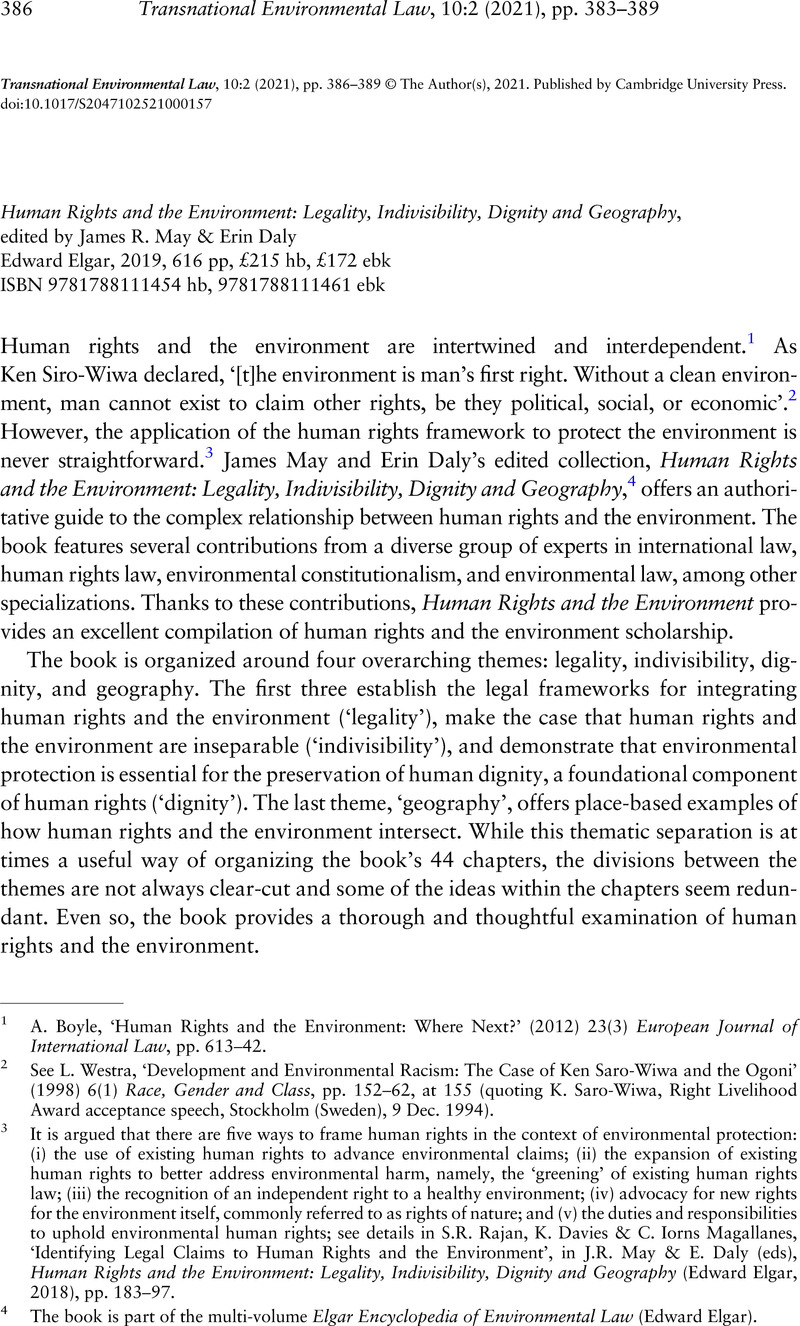No CrossRef data available.
Article contents
Human Rights and the Environment: Legality, Indivisibility, Dignity and Geography, edited by James R. May & Erin Daly Edward Elgar, 2019, 616 pp, £215 hb, £172 ebk ISBN 9781788111454 hb, 9781788111461 ebk
Published online by Cambridge University Press: 01 July 2021
Abstract

- Type
- Book Reviews
- Information
- Copyright
- Copyright © The Author(s), 2021. Published by Cambridge University Press.
References
1 Boyle, A., ‘Human Rights and the Environment: Where Next?’ (2012) 23(3) European Journal of International Law, pp. 613–42CrossRefGoogle Scholar.
2 See Westra, L., ‘Development and Environmental Racism: The Case of Ken Saro-Wiwa and the Ogoni’ (1998) 6(1) Race, Gender and Class, pp. 152–62Google Scholar, at 155 (quoting K. Saro-Wiwa, Right Livelihood Award acceptance speech, Stockholm (Sweden), 9 Dec. 1994).
3 It is argued that there are five ways to frame human rights in the context of environmental protection: (i) the use of existing human rights to advance environmental claims; (ii) the expansion of existing human rights to better address environmental harm, namely, the ‘greening’ of existing human rights law; (iii) the recognition of an independent right to a healthy environment; (iv) advocacy for new rights for the environment itself, commonly referred to as rights of nature; and (v) the duties and responsibilities to uphold environmental human rights; see details in Rajan, S.R., Davies, K. & Magallanes, C. Iorns, ‘Identifying Legal Claims to Human Rights and the Environment’, in May, J.R. & Daly, E. (eds), Human Rights and the Environment: Legality, Indivisibility, Dignity and Geography (Edward Elgar, 2018), pp. 183–97Google Scholar.
4 The book is part of the multi-volume Elgar Encyclopedia of Environmental Law (Edward Elgar).
5 Boyd, D.R., The Environmental Rights Revolution: A Global Study of Constitutions, Human Rights, and the Environment (University of British Columbia Press, 2012)Google Scholar.
6 United Nations Framework Convention on Climate Change (UNFCCC), New York, NY (US), 9 May 1992, in force 21 Mar. 1994, available at: https://unfccc.int.
7 Knox, J.H. & Pejan, R., ‘Introduction’, in Knox, J.H. & Pejan, R. (eds), The Human Right to a Healthy Environment (Cambridge University Press, 2018), pp. 1–16CrossRefGoogle Scholar.
8 See May, J.R. & Daly, E., Global Environmental Constitutionalism (Cambridge University Press, 2014)CrossRefGoogle Scholar; May, J.R. & Daly, E., Implementing Environmental Constitutionalism: Current Global Challenges (Cambridge University Press, 2018)Google Scholar; May, J.R. & Daly, E., Environmental Constitutionalism: A Research Compendium (Edward Elgar, 2016)CrossRefGoogle Scholar; May, J.R. & Daly, E., ‘Vindicating Fundamental Environmental Rights: Judicial Acceptance of Constitutionally Entrenched Environmental Rights’ (2009) 11 Oregon Review of International Law, pp. 365–438Google Scholar; Daly, E. & May, J.R., ‘Bridging Constitutional Dignity and Environmental Rights Jurisprudence’ (2016) 7(2) Journal of Human Rights and the Environment, pp. 218–42CrossRefGoogle Scholar.


